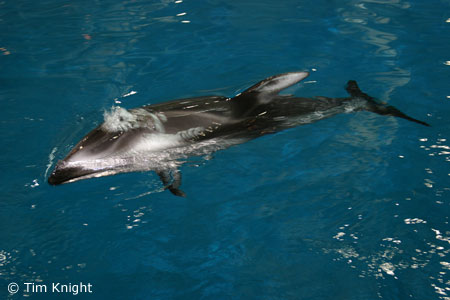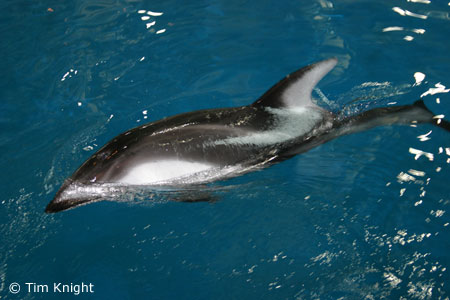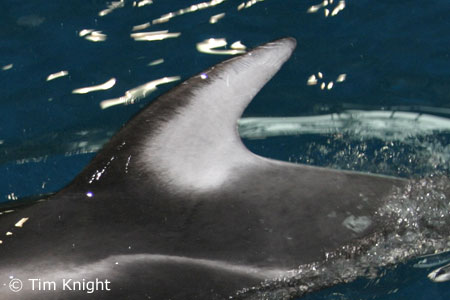
NatureMapping Animal Facts
Pacific White-sided Dolphin
 Pacific White-sided Dolphin (Lagenorhynchus obliquidens) Description: Pacific white-sided dolphins are so named because of the white coloration on their sides and underneath. The Pacific White-sided Dolphin has a short, rounded, thick beak containing 23 to 32 small, rounded slightly curved teeth in each side of the upper and lower jaws. The Pacific white-sided dolphin is attractively marked with gray, black and white. Its back is dark gray and its sides are light gray with thin, white stripes that extend from above the eye along the sides, widening towards the tail; its belly is white. It has a black beak and lips and a black ring around each eye. 
The dorsal fin, at the center of the back, is tall and sharply hooked. The leading edge of the fin is black and the cresent-shaped rear section is light gray. Its small rounded flippers are rounded at the tips. They are energetic and quite active and frequently seen leaping, belly flopping, and somersaulting in the ocean. This dolphin is a strong, fast swimmer and enthusiastic bow rider, often staying with moving vessels for extended periods of time.
Size: These dolphins reach a length of 7 to 8 feet (2.1 to 2.4 m) and weigh 300 pounds (150 kg). See drawing showing the relative size of the dolphin to a human diver.
Often referred to as "lag" because of its long scientific name - Lagenorhynchus. Range / Habitat: The Pacific White-sided Dolphin inhabits temperate, coastal waters in the North Pacific, avoiding both tropical or Arctic waters. Its range extends from Amchitka Island in the Aleutians, to the Gulf of Alaska south along the coast of North America to the tip of Baja California.
Diet: Pacific White-sided Dolphins eat squid and small schooling fish such as anchovies, herring, sardines, hake, salmon, rockfish, and pollock. 
Behavior: Pacific White-sided Dolphins are often found in large herds of 90 to 100. The herds are made up of animals of both sexes and all ages. Since they share the same range, they are most commonly seen with northern right-whale dolphins and are often seen accompanying other dolphins and large whales.
Reproduction: Pacific White-sided Dolphin females have their first calf when they are 7-9 years old. The length of pregnancy (gestation period) is around 12 months. When the calves are first born they are approximately one meter (3ft) long and weigh roughly 15 kg. Females will nurse their calves for 8-10 months. Females, give birth approximately every 4.5 to 5 years. Life span: The maximum age recorded for a female Pacific white-sided dolphin is 46. The oldest male recorded is 42.
Did you know?

Pacific White-sided Dolphin More information:
|
